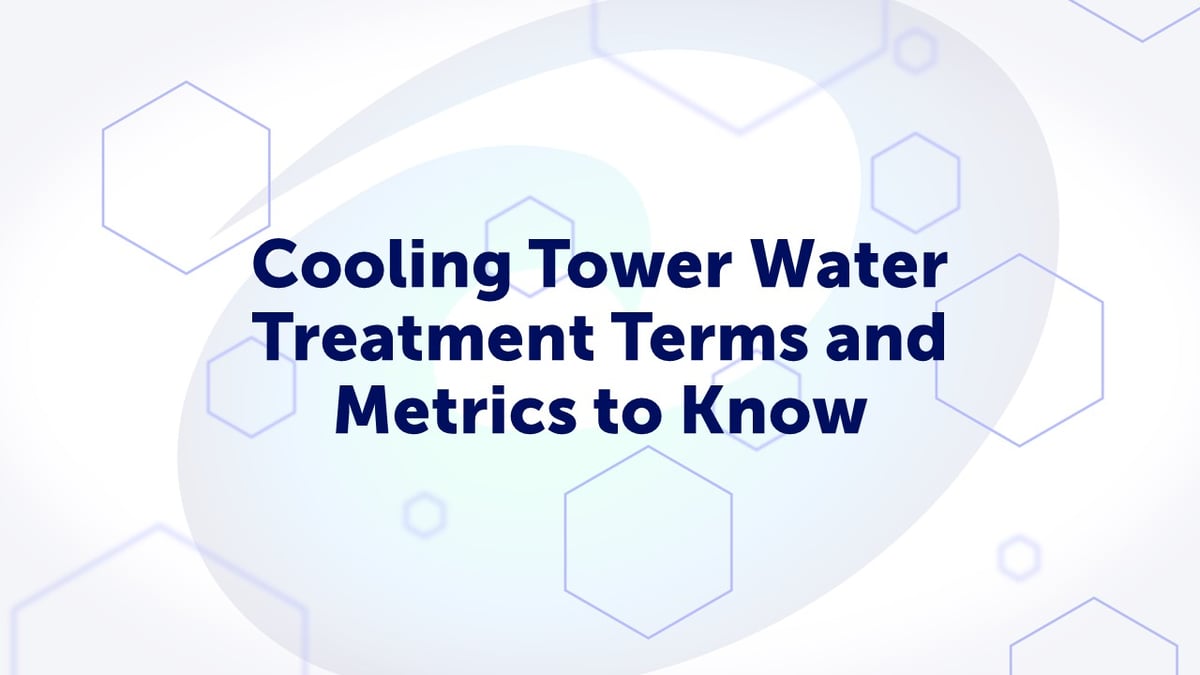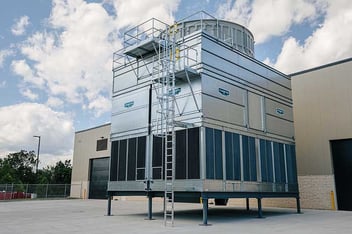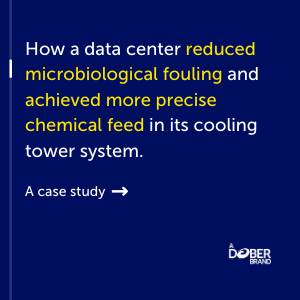Cooling Tower Water Treatment Terms, Metrics You Need to Know
If you're here, you probably already know — or maybe you're looking to learn more — that cooling tower water treatment is critical to a wide range of major operations, including manufacturing facilities, power plants, schools, hospitals, data centers, office buildings and much more.
Cooling tower water treatment is vital to the safe and effective management of your cooling tower system.
As such, it's important to speak the language of cooling tower water treatment. We know cooling tower water treatment is important and why it's important, so let's dive into the lingo of cooling tower water treatment and take that understanding to the next level.
Key Cooling Tower Water Treatment Terms to Know
Let's dive into the cooling tower water treatment terms you should know (you can read through the article or flip through the slideshow below).




















Alkalinity
This will be discussed further in the pH entry below, but alkalinity — or M-Alkalinity — is an important measurement for your cooling tower water treatment program of the amount of carbonates, bicarbonates and hydroxides in your process water.
Generally, you want your cooling tower process water on the alkaline side; however, if it is too alkaline, you can get formation of scale (e.g., calcium carbonate). That's why cooling tower water treatment programs often include pH adjusters to bring pH down to optimal levels as needed, particularly as alkalinity levels increase as cycles of concentration increase.
Biocides
Biocides are vital to any effective cooling tower water treatment program. Cooling towers offer a welcoming environment for microbial growth; if bacterial growth within the system is present, it could lead to fouling (see "Fouling" entry), decreased efficiency and distribution of bacteria via aerosols that could lead to illness if inhaled. Perhaps the most well known example of this is Legionnaires' disease.
So, biocides are the chemicals that mitigate and prevent microbial growth in your cooling tower system. These chemicals can be delivered in liquid or solid forms.
Blowdown
Blowdown is the water flushed out of the system due to higher levels of mineral concentration. Simply put, the more cycles of concentration you can get out of your system, the more you save on water in the form of "make-up" water (see the "Make-up" entry below).
Blowdown also includes leaks, drift and windage.
Cooling Tower Basin
The cooling tower basin is where cooled process water is collected before it is recycled in the system.
Corrosion
As with many industrial processes, corrosion is a cause for concern in the cooling tower system. Contaminants in the cooling tower system can lead to corrosion of various surfaces within the cooling tower. As a result, the heat-transfer capacity of the system and its efficiency declines.
Counterflow
A counterflow cooling tower is a type of cooling tower in which air flows counter to the direction of the process water.
Crossflow
Meanwhile, a crossflow cooling tower is a type of cooling tower in which the air moves horizontally with the direction of the process water.
Cycles of Concentration
Cycles of concentration is one of the most important concepts in the world of cooling tower water treatment. To calculate your cycles of concentration, you need to determine the ratio of dissolved solids in your blowdown water relative to your make-up water.
"From a water efficiency standpoint, you want to maximize cycles of concentration," the Department of Energy explains. "This will minimize blowdown water quantity and reduce make-up water demand. However, this can only be done within the constraints of your make-up water and cooling tower water chemistry. Dissolved solids increase as cycles of concentration increase, which can cause scale and corrosion problems unless carefully controlled."
Drift
While much of the heat transfer in the system occurs via evaporation, some water is carried out via "drift," or by a mist or small droplets. Windage can be a contributor to drift.
"Drift loss is small compared to evaporation and blowdown and is controlled with baffles and drift eliminators," the Department of Energy notes.
Evaporation
The process by which most heat is transferred out of a cooling tower system.
Fill
The cooling tower "fill" area is the surface on which the heated water is distributed as it enters the cooling tower system. From there, air contacts the water and heat is expelled from the system via evaporation.
Fouling
Fouling is the general term for when material builds up and/or deposits on cooling tower surfaces, thus impacting the system's heat-transfer capacity. In addition to scaling, fouling is often referred to in the form of microbiological fouling, which is when microbial growth occurs within the system.
Cooling towers provide a welcoming environment — warm and wet — for microbial growth, which is why your cooling tower water treatment program must address the issue with the use of effective biocides.
Heat Load
Heat load, measured in BTUs per hour, is the amount of heat that needs to be removed from the cooling tower process water. Heat load is an important parameter in determining tower size and cost.
To determine heat load, multiply gallons per minute by 500 and by the temperature delta of cold water from the cooling tower and hot water going into the system. The formula is also written out below:
Heat load=GPM x 500 x ΔT
Make-up
This term is related to the "blowdown" term above. Make-up water is exactly what it sounds like: it's the water used to make up for the loss in "blowdown" water.
In general, cooling tower water treatment seeks to make a more efficient process that leads to less need for make-up water. In short, an environmentally conscious and more sustainable process would call for less water.
As the Department of Energy explains, make-up is equal to the sum of blowdown, evaporation and drift in the system. However, as noted previously, when cycles of concentration increase, so does alkalinity and, in turn, the possibility of scaling.
pH
In most cooling tower systems, you will typically see a pH level of anywhere between 7.0-9.5. However, some systems do run outside of that range (i.e., more acidic or more alkaline). You don't want your process water to be too acidic, as that can lead to corrosion of various surfaces. However, if your process water is too alkaline, that can promote the formation of scale. Alkalinity in the water increases as evaporation occurs, meaning a rise in pH.
Scale
When water is evaporated out of the system, remaining levels of solids can coat surfaces of the cooling tower, i.e., scale. What does that mean for the system and your cooling tower water treatment needs? Deposition of scale can negatively affect the heat-transfer capacity of the system.
Furthermore, deposition of scale can also provide opportunity for microbial growth.
In order to combat scale, you need scale inhibitors in your cooling tower water treatment program.
Tons
Terms used to express the capacity or size of the cooling system. One ton is equivalent is equivalent to 12,000 BTU per hour.
A ton of refrigeration represents the rate of cooling produced when a ton of ice that weighs 2,000 pounds melts during a 24-hour day.
TDS (total dissolved solids)
The total amount of inorganic and organic molecules in the cooling tower process water. Those solids could include things like calcium, magnesium, silica and chloride, among others. Calcium carbonate is the most commonly found scaling deposit in the cooling tower system.
In short, you don't want your TDS to get too high.
Think of a swimming pool. You and your family and friends are enjoying some time in the pool. There are a few pool toys floating around in there: a pool noodle or two, maybe a floating pool chair, a couple of smaller toys for the younger children. Bottom line, there's room for you to move around and enjoy the space offered by the pool.
Now add, say, 30 more pool noodles, 20 more pool chairs and a flock of rubber ducks. There isn't as much space to move around and your pool experience isn't quite as enjoyable if you're constantly maneuvering around these various obstacles. Not only that, maybe all that flotsam and jetsam finds its way to the pool skimmers and drains, covering or clogging them up. If that happens — and you don't take time to address the problem — the pool system won't be able to effectively circulate clean, safe water for you to swim in.
Meanwhile, if TDS gets too high in your cooling tower system, that means those solids could lead to corrosion, deposition of scale and microbial growth. That, in turn, contributes to lower heat-transfer capacity and a less efficient system.
Water Balance/Mass Balance
Your make-up equals evaporation plus blowdown.
Windage
Water lost from the cooling tower system when winds blows water droplets out of the cooling tower.
---
To learn more about how these different aspects of the cooling tower system work in tandem with Smart Release Technology, download the Smart Release Generation 2 e-book below.




